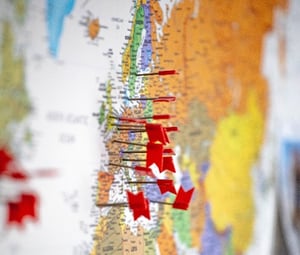No tariffs and no quotas - that’s what everyone said when the UK and EU announced the new Trade and Cooperation Agreement in December 2020 – and it is true, up to a point. UK originating goods are tariff free when entering the EU. EU originating goods are tariff fee when entering the UK. But determining the origin of goods is not always straightforward, and no proof is required until 1st January 2022. What unpleasant surprises are waiting to emerge in the New Year?
The origin of goods, for customs purposes, is not necessarily the country from which they were shipped. A trivial example would be importing a container of toys from China to the UK. If those same toys were then sold to customers in the EU, they would retain their Chinese origin and tariffs would apply. The EU/UK Trade and Cooperation Agreement (TCA) devotes around 80 pages to defining Origin, which can be roughly summarised in three points. Goods originate in a territory (UK or EU) if:
- - they wholly originate. That is if they were: dug out of the ground; grown and harvested; born and raised; hunted or fished; produced entirely from other items that were wholly obtained, or
- - they have undergone substantial transformation. There’s over 50 pages just on this, but generally it means that the tariff classification of the goods changes sufficiently, or
- - the proportion (weight or value, depending on the type of goods) of non-originating material is below a certain threshold (again, depending on the type of goods).
The last two points are helped a little by a mechanism called cumulation. This states that if I use goods from the EU to make something (substantial transformation) in the UK, the EU goods count as having UK origin, and vice versa. This encourages sourcing of materials from both the EU and UK.
Having read the summary above, it is easy to see how some companies will find it difficult to determine the origin of their products and keep their data updated as required. Doubtless many mistakes and incorrect assumptions will be made, but surely these will be identified and corrected before much damage is done? Unfortunately, this is another ticking time bomb. The current requirement is simply for exporters to make a Statement on Origin, usually on the commercial invoice, and for importers to register the preferential origin on the import declaration. Both the UK and the EU have delayed the requirement for anyone to provide proof of origin until 1st January 2022. Failure to provide this proof, if requested by the authorities, could result in back-dated liabilities for import duty, increased checks, loss of access to special customs procedures or even fines. This could impact a full year’s worth of imports, so the cost and disruption could be significant.
As if this weren’t enough, origin has one more trick to play. The best example of this concerns supply of goods to Ireland. It is common practice to supply the same products to UK and Irish markets. Where these products are sourced from continental EU countries, it is also common practice to have a joint stockholding in the UK (specifically, in Great Britain rather than Northern Ireland). However, products of EU origin are not exempt from tariffs when they are re-imported into the EU. In fact, they are liable for import duty at WTO rates. Unsurprisingly, this came as a shock to many businesses, and it continues to hamper efficient supply of goods into the Irish market. Various workarounds exist, but they all have drawbacks. For example:
- - Ship goods direct from continental EU to Ireland, either via sea or using Transit procedures to cross the UK on road. This increases transport costs and destroys the synergies of a joint stockholding.
- - Hold goods in customs bond while they are in the UK, which is administratively complex.
- - Claim Returned Goods Relief for goods shipped to Ireland, which is also administratively complex and (some would argue) is not in the spirit of a procedure intended to facilitate product repair.
In short, origin is one more example of a post Brexit cliff edge. There is every possibility that incorrect declarations are currently being made and that the liability will not be discovered until 2022. There is a further risk that businesses may decide to reduce the range of products they offer or withdraw entirely from markets that have become difficult to supply. With so many other challenges at the moment, it would be understandable if some good businesses fell victim to one or both of these issues. The best insurance is to act now. Understand the origin of your products and collect the evidence necessary to defend your assessments. Better a slight distraction now, rather than a full-blown crisis later.
If you need help or have concerns, please contact our Partners in the UK:





.jpeg?width=290&name=067A0687%20(1).jpeg)